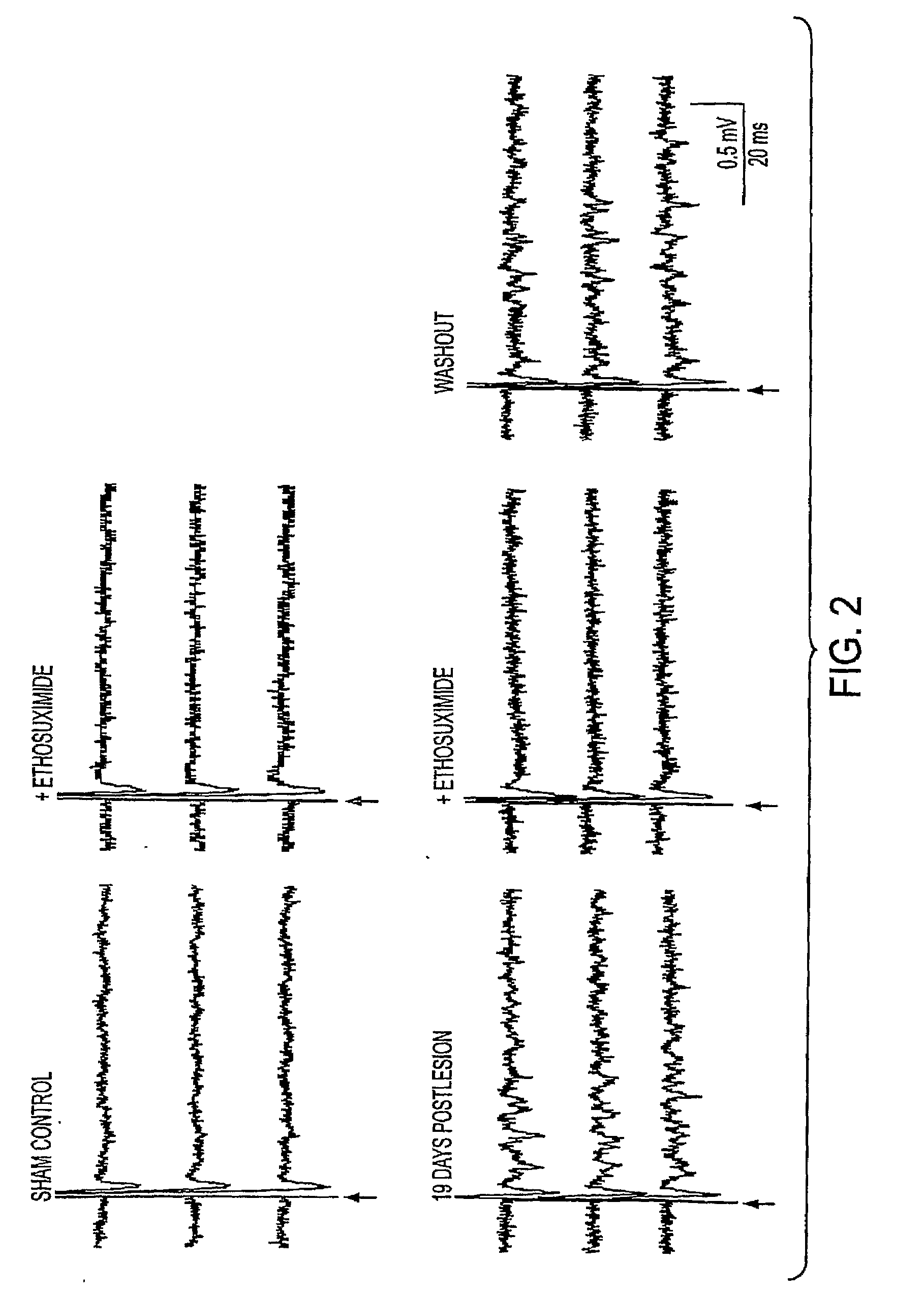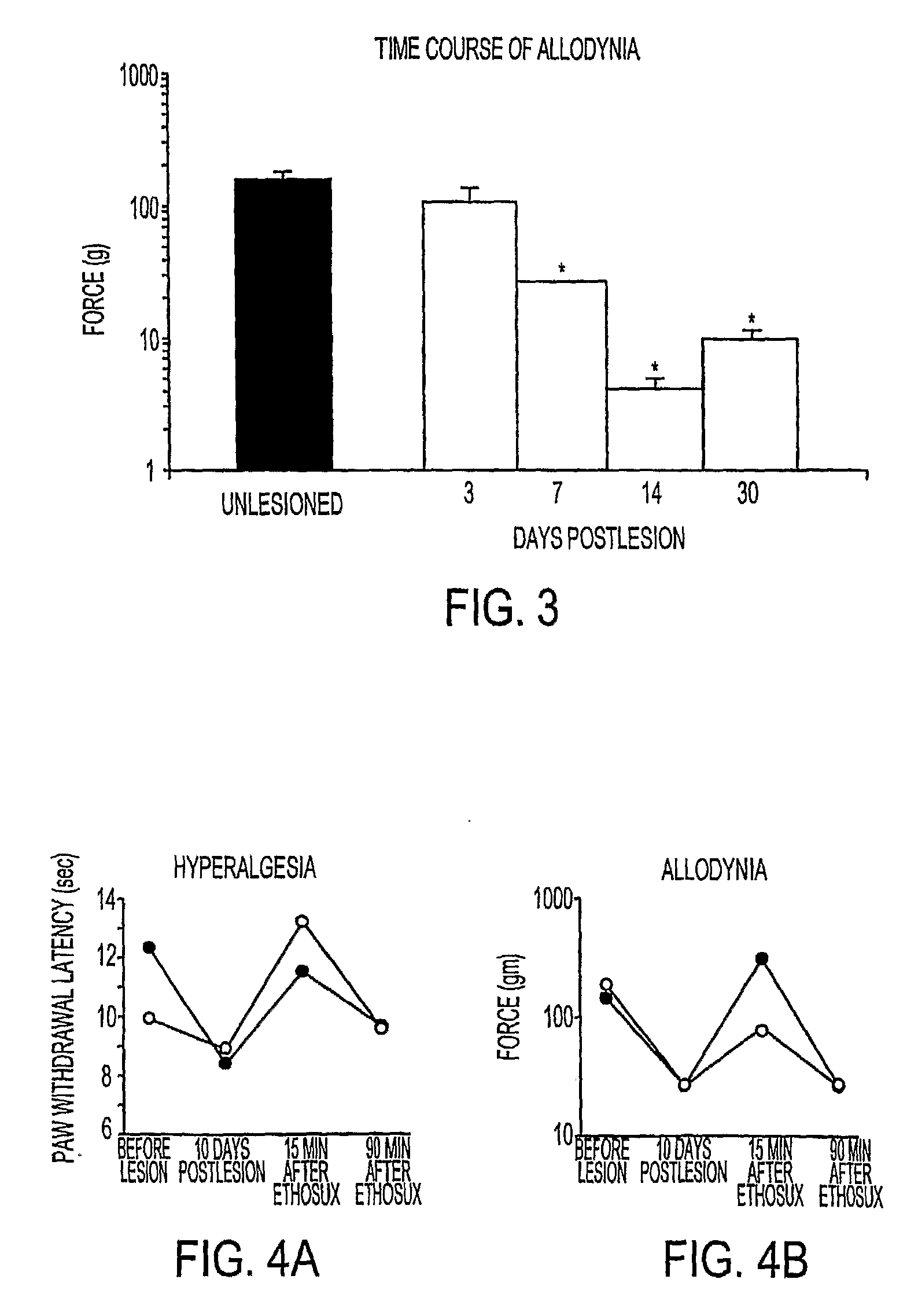Method for treating central pain syndrom or for inducing centrally generated pain in an animal model
a central pain syndrome and animal model technology, applied in the field of central pain syndrome treatment and central pain syndrome animal model, can solve the problems of high suicide rate of cps sufferers, severe pain and lack of effective treatment, and significant neurological problem of cps
- Summary
- Abstract
- Description
- Claims
- Application Information
AI Technical Summary
Benefits of technology
Problems solved by technology
Method used
Image
Examples
example 1
[0050]It may be expected based on previous studies in the laboratory of the present inventor that partial denervation and removal of the majority of the excitatory input to area CA1 would result in a quiescent population of cells. In fact, local stimulation within area CA1 triggers prolonged, abnormally oscillatory synaptic responses in lesioned cultures that are never seen in normally innervated tissue (FIG. 1, top row), but only with a delay of 7 or more days after the injury (Wei et al., 2003). The reason is not that denervation increases glutamate receptor expression in CA1 cells, akin to the well known phenomenon of denervation suprasensitivity in muscle. To confirm, the laboratory of the present inventor used photolysis of caged glutamate to compare the responses of CA1 cell dendrites in lesioned and unlesioned cultures.
[0051]In control cultures, distal, terminal dendritic branches of CA1 cells respond to weak photolysis of glutamate with passive subthreshold depolarizations. ...
example 2
Comparing the Excitability of the VB in Ex Vivo Thalamic Brain Slices from Rats in which Ascending Spinal Sensory Pathways have Been Lesioned with Slices from Sham Operated Control Rats
[0055]The present inventor hypothesizes that thalamic relay cells in VB respond homeostatically to the decrease in afferent activation with a delayed increase in their excitability, apparent electrophysiologically as prolonged burst responses. This hypothesis will be tested by preparing ex vivo thalamic slices containing the VB from sham operated control rats and rats lesioned 1, 3, 7, 14, and 28 days earlier.
[0056]The sites of denervation in the thalamus will first be determined by performing classical silver stains for degenerating axons. Rats will be perfused with paraformaldehyde at 2, 3, and 5 days after the lesions, and cryostat sections will be cut through the thalamus at 15 μm in thickness. A modified version of the Gallyas silver stain will then be used to reveal the degenerating terminals of...
example 3
Comparing the Intrinsic Excitability of Thalamic Relay Neurons in the VB in Control and Partially Denervated Thalamic Brain Slices
[0065]The present inventor predicts that hyperexcitability in denervated VB cells may result from increased intrinsic excitability. T-type Ca2+ currents in thalamic relay cells have been shown to be affected by injury (Chung et al., 1993) and an increase in T-type or H-type currents, or a decrease in a K+ current, could also produce increased bursting. This hypothesis will be tested by using straightforward whole-cell current- and voltage-clamp recording from VB relay cells in thalamic slices taken at the optimum time and place after spinal lesion, as determined in the experiments of Example 2, and compared to data from slices taken from sham operated control rats. Recordings will be performed in extracellular saline containing glutamate and GABA receptor antagonists so that intrinsic neuronal excitability can be studied in the absence of synaptic influen...
PUM
| Property | Measurement | Unit |
|---|---|---|
| Mass | aaaaa | aaaaa |
| Dimensionless property | aaaaa | aaaaa |
Abstract
Description
Claims
Application Information
 Login to View More
Login to View More - R&D
- Intellectual Property
- Life Sciences
- Materials
- Tech Scout
- Unparalleled Data Quality
- Higher Quality Content
- 60% Fewer Hallucinations
Browse by: Latest US Patents, China's latest patents, Technical Efficacy Thesaurus, Application Domain, Technology Topic, Popular Technical Reports.
© 2025 PatSnap. All rights reserved.Legal|Privacy policy|Modern Slavery Act Transparency Statement|Sitemap|About US| Contact US: help@patsnap.com



